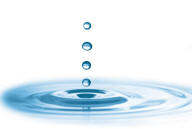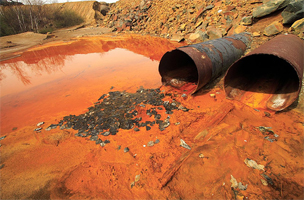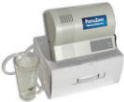Our tendency is to blame it on the big factory up stream. And while industry has certainly played its part in our water contamination problems, it is “us” individuals that are the most to blame. The majority of the contaminants found in our drinking water can be traced back to improper or excessive use of ordinary compounds like lawn chemicals, gasoline, cleaning products and even prescription drugs. Once we realize that everything that goes down the drain, on our lawns, on our agricultural fields or into the environment by any means… eventually winds up in the water we drink, we begin to see just how fragile our water supplies really are. Our municipal water treatment facilities are not designed (or effective) for removing these synthetic chemicals and typically only consist of sand bed filtration and chlorine disinfection, much like a standard swimming pool filter. For the most part today’s water treatment facilities are much the same as they were at the turn of the century.
One of America’s leading authorities on water contamination, Dr. David Ozonoff of the Boston University Of Public Health warns that, “the risk of disease associated with public drinking water has passed from the theoretical to the real.” Many illnesses that in the past could not be linked to a probable cause, can now be directly linked to toxins in our drinking water. The use of pesticides and herbicides has become so excessive that they are now commonly found in household tap water with alarming frequency. A 1994 study of 29 major U.S. cities by the Environmental Working Group found that all 29 cities had traces of at least one weed killer in the drinking water. The report titled “Tap Water Blues“ went on to say that “Millions of Americans are routinely exposed to one or more pesticides in a single glass of tap water”. These first ever “tap water testings” found two or more pesticides in the drinking water of 27 of the 29 cities, three or more in 24 cities, four or more in 21 cities, five or more in 18 cities, six or more in 13 cities and seven or more pesticides in the tap water of five cities. In Fort Wayne Indiana nine different pesticides were found in a single glass of tap water! As a startling side note it was reported that in these 29 cities 45,000 infants drank formula mixed with tap water containing weed killers and that “ over half of these infants were swallowing 4 to 9 chemicals in every bottle!”The tragic health effects of consuming these highly toxic chemicals are magnified many times over for small children because their systems are more sensitive and still developing. Small children also consume a much larger volume of fluids per pound of body weight and therefore get a bigger dose, yet none of these factors are considered when the EPA’s maximum contaminant levels are set. The National Academy of Sciences issued a report in 1993 on this subject and stated that “children are not little adults, their bodies are less developed and incapable of detoxifying certain harmful compounds.” Another major flaw in the "estimated risks" of chemicals in our drinking water is the false assumption that only that one chemical is being consumed. The regulations are set based on what is assumed safe for a 175 pound adult drinking water with only that one chemical present and does not take into account the combined reacrions and toxicity of two or more chemicals. (Let alone 100s!)
Regardless of the differing opinions, it is safe to assume that there is NO acceptable level for pesticides, weed killers, or chlorine, MTBE, etc.. in our drinking water. In America each year, we use over 2.2 billion pounds of pesticides, or eight pounds for every man woman and child in the country. Industrial solvents like TCE (Trichloroethylene) and Benzene make their way into our water supplies from literally hundreds of sources. Airports and military bases degrease planes and engine parts with TCE, one of the most concentrated toxins in existence. One teaspoon of TCE will render over 250,000 gallons of water undrinkable, and yet thousands of gallons are used in uncontained applications each day! Perchlorethelyne, cyanide, and benzene are used in such common industries as bottled water, food processing plants, dry cleaning, car washes, photo processing, etc.. much of which ends up going down someone's drain and into our water supplies. It has been shown that areas with the highest levels of these man made carcinogens in their water supplies also have the highest incidence of cancer. Cancer extracts a staggering toll from our society, one in every seven people will die from this man made disease. According to the Center For Disease Control “Death from cancer is increasing more rapidly than is the population”. It is now widely accepted that cancer is an environmental disease. The World Health Organization and the National Cancer Institute both suggest that most human cancers, perhaps as many as 90% are caused by chemical carcinogens in the environment. This realization is paramount for change because it means that most cancers could be prevented by minimizing or eliminating our exposure to chemical carcinogens. While the powerful chemical industry argues that the levels of these toxins in the environment are not significant, scientific evidence has shown otherwise. A National Cancer Institute report to the Surgeon General concluded that “no level of exposure to a chemical carcinogen should be considered toxicologically insignificant for man". We spend billions of dollars each year seeking a cure for cancer. The disease is merely a result of the real problem, environmental pollution. If we were to direct these billions of dollars and the same intense effort towards curing the problem (pollution) instead of learning to live with the result (cancer), we would do future generations a great service, and we could realistically stop the “cancer epidemic". What about bottled water contamination? FDA recently proposed regulations that would establish standard definitions for all bottled water products, and set new limits for approximately 50 chemical and other contaminants that may be present in bottled water. FDA has already established quality standards for 31 contaminants. Under a rule published in the Jan. 3, 1993, Federal Register, the allowable levels for seven synthetic volatile organic chemicals were amended to comply with maximum contaminant levels set by EPA. The seven chemicals are: benzene, carbon tetrachloride, 1,2-dichloroethane, 1,1- dichloroethylene, 1,1,1-trichloroethane, trichloroethylene, and vinyl chloride. Proposed regulations would also revise or affirm maximum levels for inorganic substances such as lead, copper, mercury, barium, and cadmium. The proposed regulations would also establish or modify permitted levels for 28 synthetic organic chemicals, including 10 synthetic volatile organic chemicals, 17 pesticides, and polychlorinated biphenyls. In all, the proposed regulations would establish 27 new chemical levels and amend the existing allowable levels of many others. The point is...
even bottled water is not safe to
drink either, especially when ill. Primary toxic poisons found in our water supply:
Organic compounds are those which contain carbon, although some carbon-containing compounds are traditionally considered inorganic. When considering inorganic chemistry and life, it is useful to recall that many species in nature are not compounds per se but are ions. Sodium, chloride, and phosphate ions are essential for life, as are some inorganic molecules such as carbonic acid, nitrogen, carbon dioxide, water and oxygen. Aside from these simple ions and molecules, virtually all species covered by bioinorganic chemistry contain carbon and can be considered organic or organometallic. Inorganic compounds can be formally defined with reference to what they are not—organic compounds. Traditionally, inorganic compounds are considered to be of mineral, not biological, origin. Complementarily, most organic compounds are traditionally viewed as being of biological origin. Over the past century, the precise classification of inorganic vs organic compounds has become less important to scientists, primarily because the majority of known compounds are synthetic and not of natural origin. Furthermore most compounds considered the purview of modern inorganic chemistry contain organic ligands. The fields of organometallic chemistry and bioinorganic chemistry explicitly focus on the areas between the fields of organic, biological, and inorganic chemistry.
Health Effects of a Few Selected Drinking Water Contaminants
Source: Washington State Department
of Health
- see more on bottled water contamination - see more research claims about water
|
|
|
|
Call Today 951-303-3471 9-5 Pacific (12-8 Eastern)
|
Statements about water pollution, Waterboy water filters, Kangen water machines, Wholly Water filter, The Vitalizer Plus, the P250 Ozone generator, etc. have not been reviewed by the FDA. |
|||||||||||||||||||||||||||||||||||||||||||||||||||||||||||||||||||||||||||||||||||||||||||||||||||||||||||||||||||||||





 Kangen
Water - The Most Powerful Water in Existence! Highly
alkaline, ionized, anti-oxidant rich, microclustered, powerful
living water! Flushes Toxins and Neutralizes Acid throughout
your ENTIRE body.
Kangen
Water - The Most Powerful Water in Existence! Highly
alkaline, ionized, anti-oxidant rich, microclustered, powerful
living water! Flushes Toxins and Neutralizes Acid throughout
your ENTIRE body.  P250
Ozone Generator. An ozone level of just 0.04ppm
in just 4 minutes has been shown to kill 99.9992% of all
pathogenic germs in water while destroying 99.9992% of all
pollutants in the water simultaneously!
P250
Ozone Generator. An ozone level of just 0.04ppm
in just 4 minutes has been shown to kill 99.9992% of all
pathogenic germs in water while destroying 99.9992% of all
pollutants in the water simultaneously!